If you’re looking for a reliable, easy-to-make gluten-free all-purpose flour blend, this is the one to try! It’s a versatile blend that performs beautifully in everything from cookies and muffins to bread and yeast-based recipes.
Buying the flours individually might seem like a bigger investment at first, but you’ll get a much larger quantity of flour at a better cost than most store-bought gluten-free blends. I’ve tested this blend in dozens of recipes, and it consistently delivers better structure, texture, and flavor.
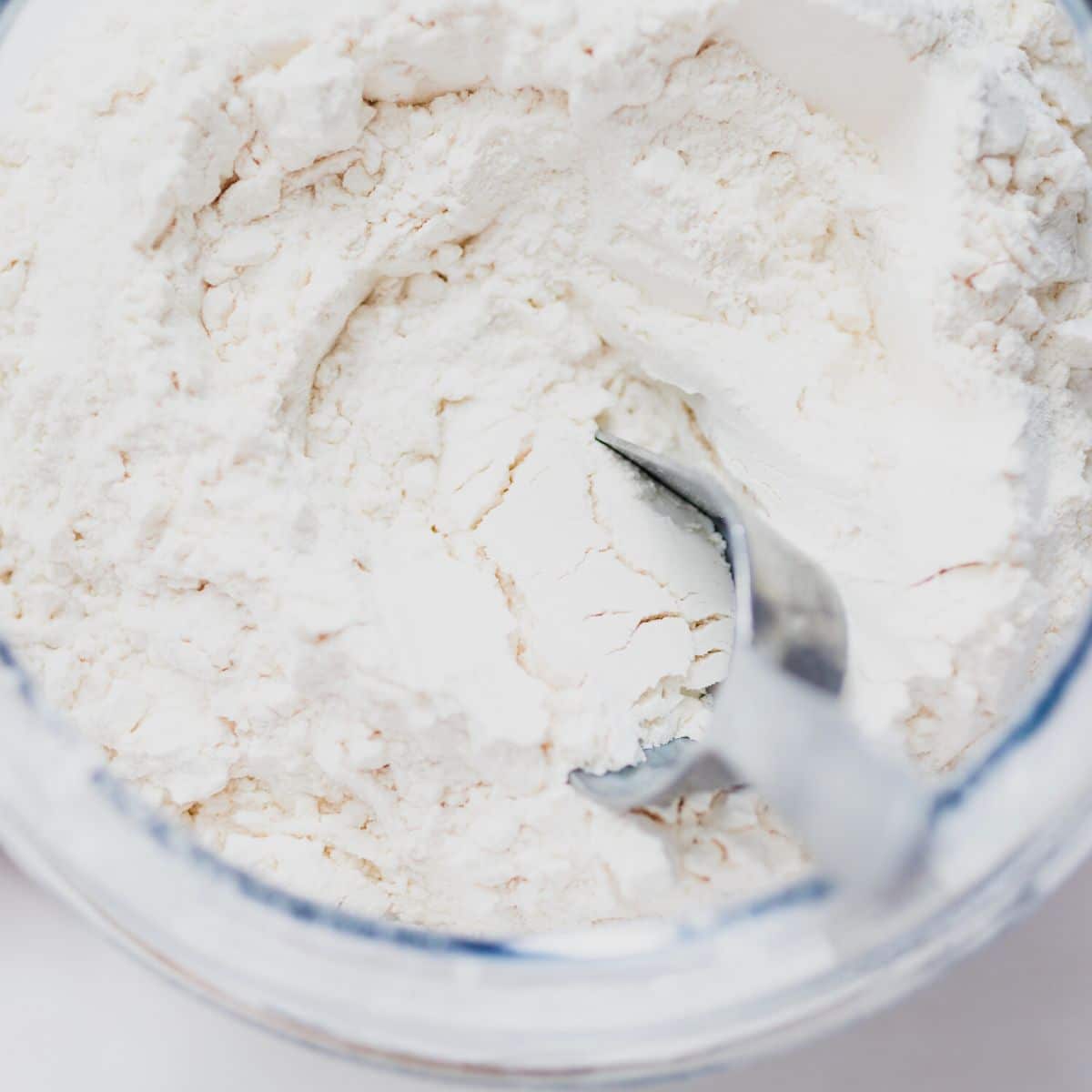
This quick and easy DIY Gluten-Free All-Purpose Flour Blend recipe is a well-tested flour blend and works in both yeasted and non-yeasted gluten-free recipes. Baked goods turn out perfectly every time.
Why Mix Your Own Gluten-Free Flour Blend?
- Versatility: My blend works well for everyday and yeast baking
- Customizable: You can use any binder. The gum-free option makes it more flexible for dietary needs. Add psyllium husk, xanthan gum, OR guar gum.
- Allergen-Friendly: Corn-free and has a nightshade-free option
- The Perfect Pantry Staple: This blend is more economical than pre-blended options. It is easy to store, and it stays fresh longer.
🔑 Sandi says: See below for the master list of the recipes I have tested this flour blend in!
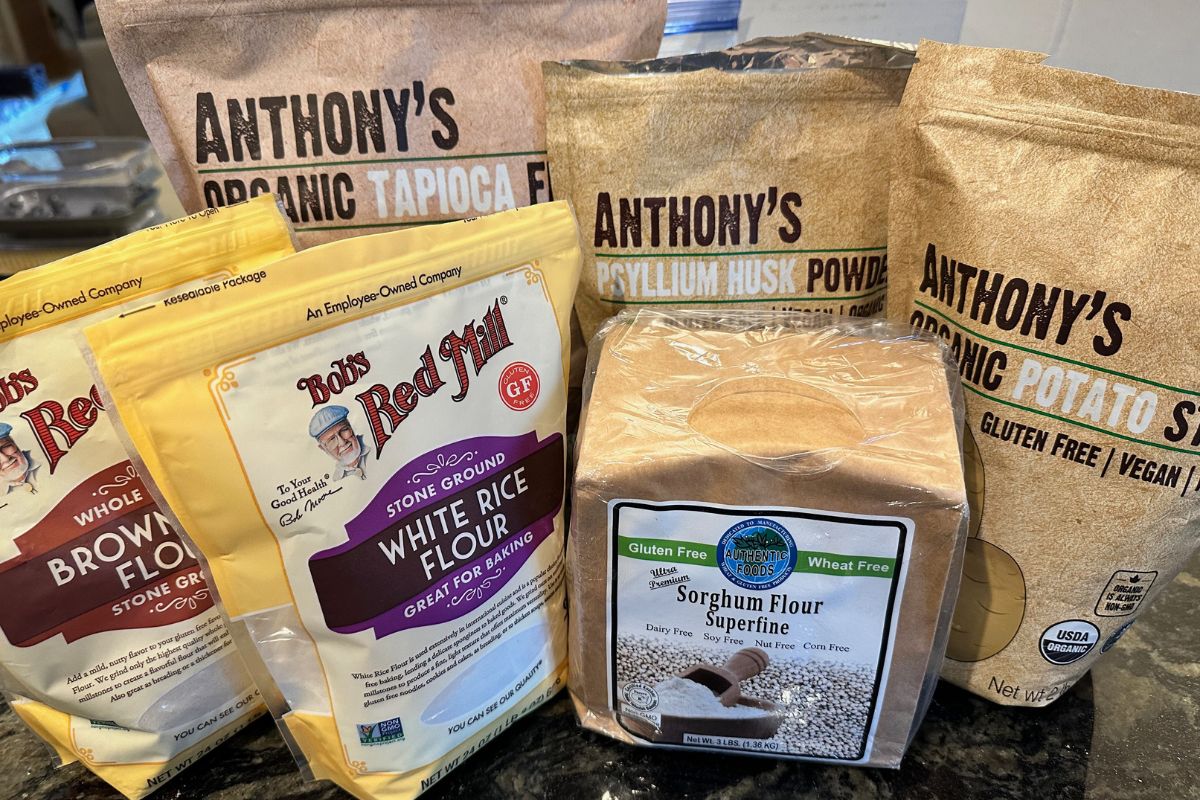
Gluten Free Flour Ingredients Notes:
For the full list of ingredients and amounts, please go to the recipe card below.
You are going to love this gluten free flour blend with sorghum flour. Let’s discuss the flour and starches I chose for this gf flour blend and “why” they work in this recipe.
There are three main binders in gluten free baking. Find out more about How Binders Work in Gluten Free Baking.
- White Rice Flour: Gives the flour blend a neutral base and helps create a smooth texture. It’s super fine, which helps keep baked goods light instead of gritty.
- Brown Rice Flour: Adds structure and a subtle nuttiness without making the blend too heavy.
- Sorghum Flour: Mimics the protein structure of wheat when combined with other flours and starches.
- Potato Starch: This helps keep baked goods moist and tender. It adds lightness and that soft, slightly springy bite.
- Tapioca Starch: Adds a little stretch and chew, which helps mimic the texture gluten usually provides.
- Psyllium Husk: I like Anthony’s brand because their psyllium husk powder doesn’t turn baked goods purple. There are three main binders in gluten free baking, and you can use psyllium, xanthan gum, or guar gum.
If you love to bake, I have a huge resources section to help. Check out my Gluten Free Baking Tips.
This post may contain affiliate links. Please read our Disclosure Policy.
Email This Recipe To Me!
How To Make Gluten Free Flour:
Are you ready to make your own gluten free baking mix? Gather your ingredients and grab a large
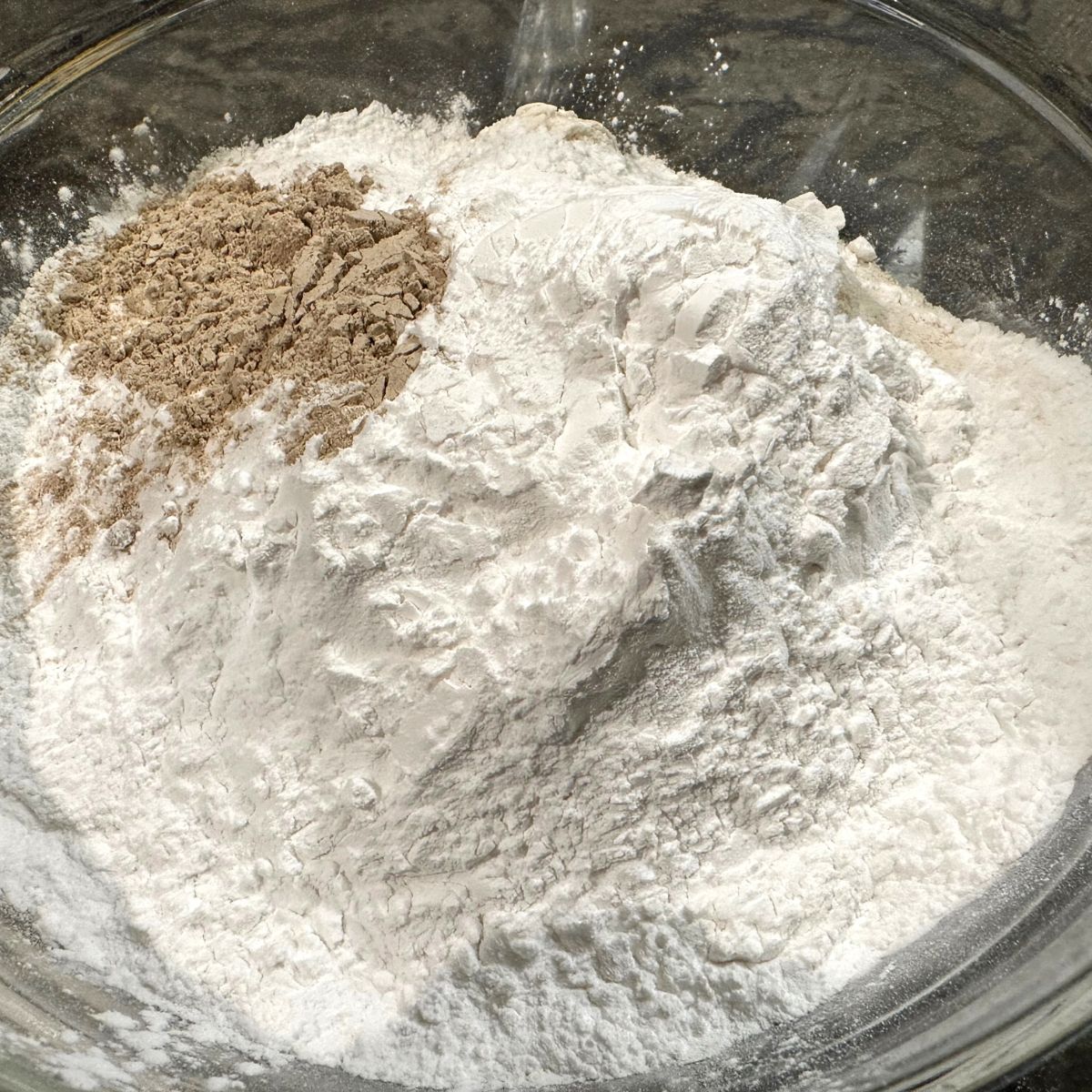
Step 1: Add the ingredients to a large mixing bowl. Use a wire whisk to blend the ingredients for one minute. In this recipe, you will want to whisk, stir with a large spoon, and then whisk again to ensure they are fully blended.
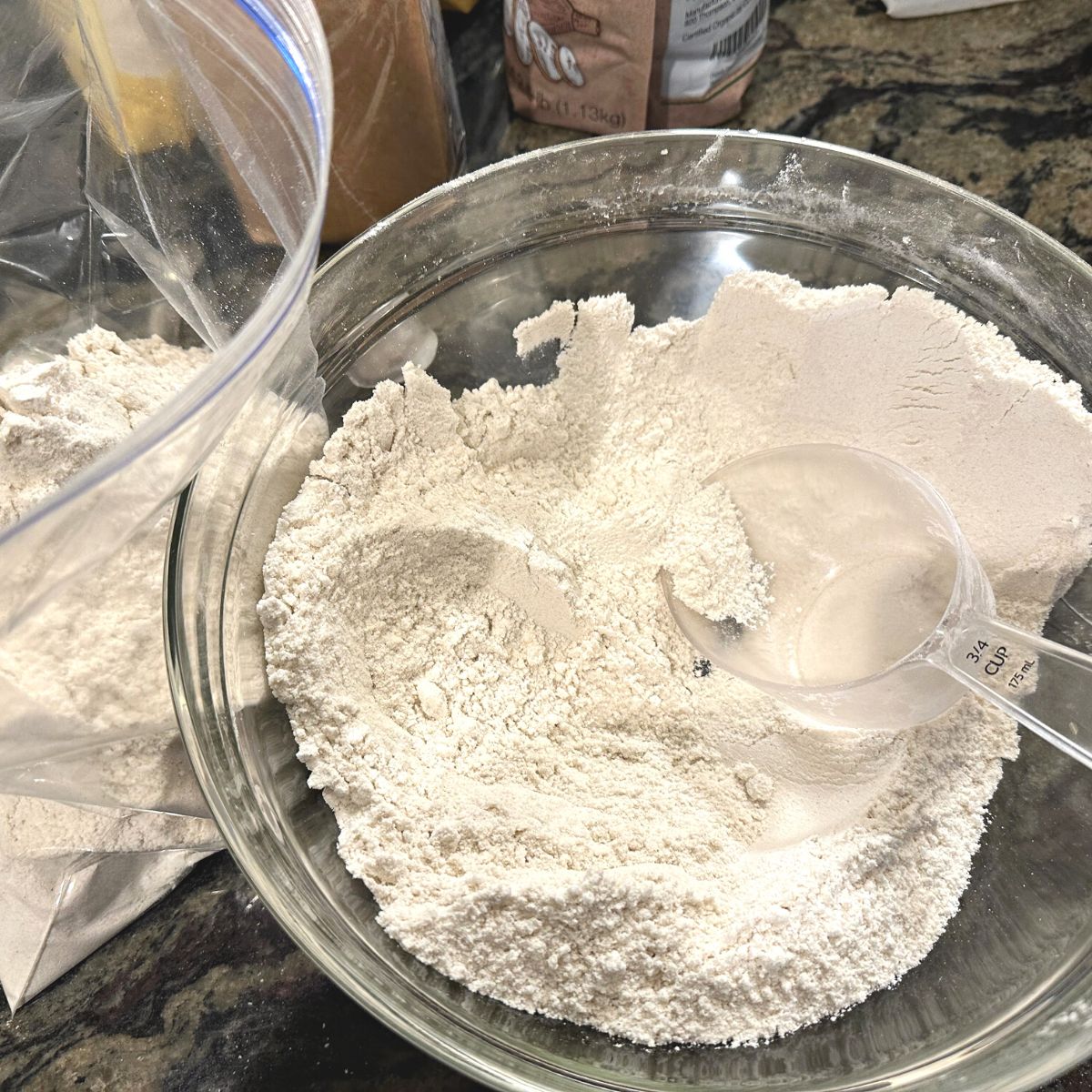
Step 2: Move the flour into a large plastic zipper bag or Mason jar. You want to be able to seal it to keep it airtight. Use it in all of your favorite recipes!
👀 Sandi Says: If you store your flour in the refrigerator, you must allow it to cool to room temperature before using it in a recipe. Otherwise, the moisture levels will be affected.
Want to try a different gluten-free blend?
- Gluten Free Flour Blend Recipe Without Rice
- Gluten Free Flour Blend Without Sorghum
- Gluten-Free Pastry and Cake Flour
Frequently Asked Questions:
Single flours can’t replicate the structure of wheat. A balanced blend gives baked goods the structure, softness, and flavor you expect.
If you prefer using pre-blended gluten free flour mixes, you can buy them in most grocery stores. I wrote a helpful article that goes over the best gluten free flour blends and the types of recipes in which each blend performs the best.
There are quite a few kinds of gluten free flour that are safe for those on a gluten free diet. Brown and white rice flour, sorghum flour, buckwheat flour, corn flour, millet flour, cassava flour, coconut flour, teff flour, oat flour (must be certified gluten free!), amaranth flour, and almond flour. You can also use specialty flour like coffee, banana, plantain, tigernut, and bean flour.
Yes, you can freeze this gluten free flour blend. Store it in a freezer bag and squeeze out the extra air. To use any flour stored in the freezer, you must allow the flour to warm to room temperature before using it in a recipe.
You can omit the psyllium husk from this blend and then add one teaspoon of xanthan gum to your recipe.
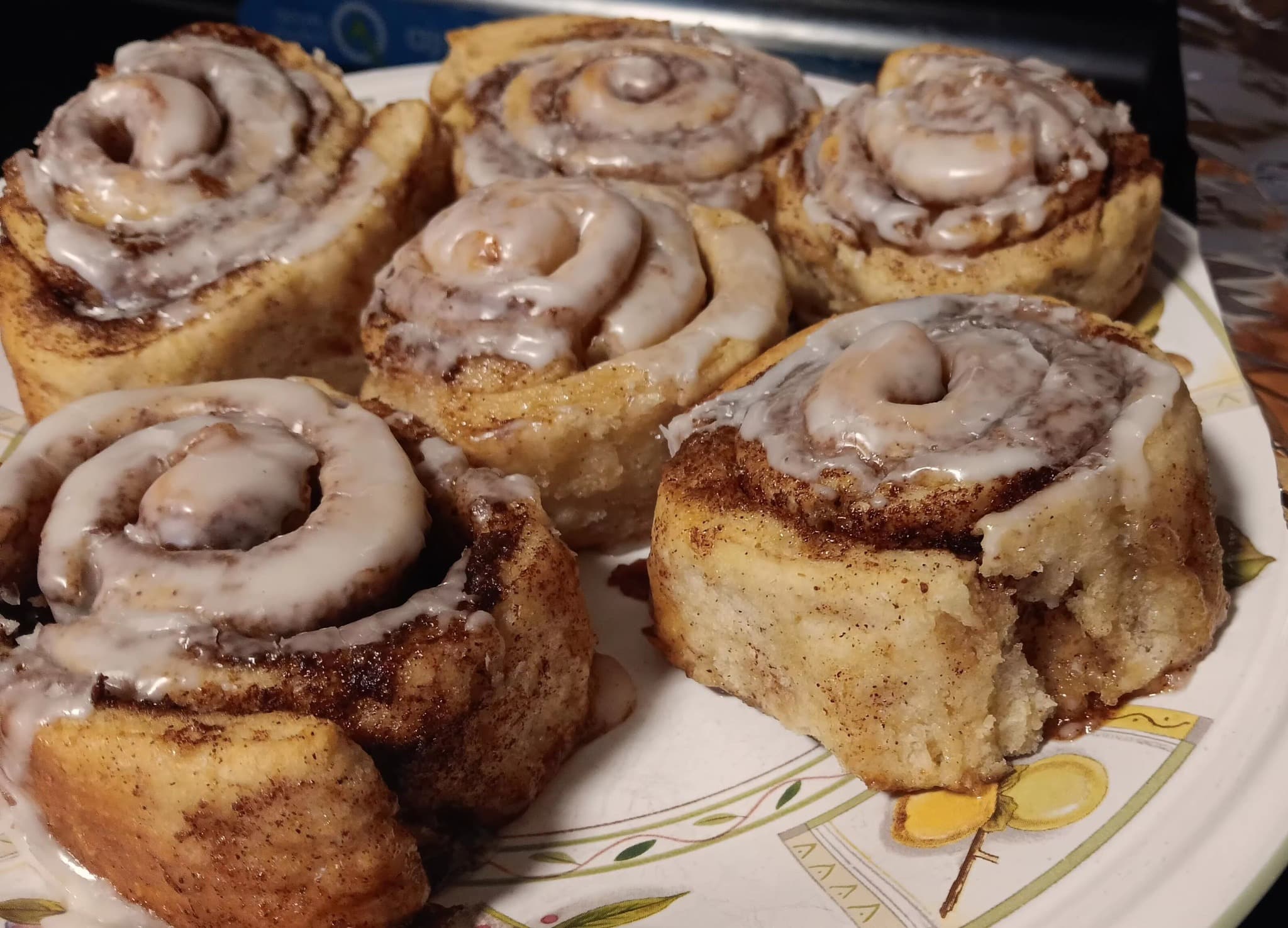
Recipes Using this Gluten-Free All Purpose Gluten-Free Blend:
Here are the recipes I have tested so far using my blend. Any notes are also here and in the recipe posts so you know if you need extra liquids.
- Gluten Free Chocolate Chip Cookies – I successfully used my flour blend in this cookie recipe.
- Gluten Free Pizza Crust – I had to add about 1/3 cup of extra water to make my gluten free pizza crust recipe. I added 2 additional teaspoons of psyllium husk powder. I will say this gluten free flour blend performed better than my favorite, the Cup4Cup brand. My blend had more of the classic chewiness I missed in crust since going gluten free. I will soon test my crust recipe with this flour blend on the grill.
- Gluten-Free Orange Bunny Rolls – No changes necessary.
- Gluten Free Pizza Rolls – Add 3-4 TBSP of water and 2 additional teaspoons of psyllium husk powder.
- Gluten Free Lemon Layer Cake – No adjustments from the original recipe are needed. My gluten free flour blend without xanthan gum worked perfectly.
- Gluten Free Peach Kuchen – No adjustments to the flour were needed.
- Gluten Free Apple Cake – No flour measurement changes are needed.
- Gluten Free Biscuits – This flour blend works well in my gluten free biscuits recipe. You will need to add 1 TBSP of additional milk to the dough.
- My Gluten Free Oat Bread – No adjustments are needed.
- Gluten Free Pancakes – This blend works perfectly with no further changes to the flour blend.
- Gluten Free Pumpkin Pancakes with sweet potato puree – Tasty, used 1/4 cup less oat milk.
- Gluten Free Muffins – I tested this gluten free flour blend in my gluten free apple muffins recipe. (Note: I used frozen cranberries in the test.) It worked perfectly without any modifications to the flour blend.
- Gluten Free Mug Cakes – This recipe works well in all of my mug cake recipes with no changes.
- Gluten Free Bread Machine Bread – This recipe worked great with no modifications.
- Gluten Free Soft Pretzels – This recipe worked great with my flour blend. No modifications are needed.
- Gluten Free Strawberry Banana Bread – This flour worked so well in my banana bread recipe; I feel confident that my flour blend will work in all my banana bread recipes.
- Gluten Free Cinnamon Rolls – My flour works in all my roll recipes, including my Gluten Free Gingerbread Rolls, Gluten Free Orange Rolls, and Gluten Free Lemon Rolls.
- Gluten Free Coffee Cake – One of my readers used this blend to make this coffee cake. No modifications were needed, and it got rave reviews.
- Gluten-Free Dairy-Free Crepes – My blend worked well in my crepes recipe. No changes to the original recipe.
- This flour works in ALL of my Gluten-Free Sourdough Recipes!
Love This Recipe?
💬 Have You Tried This Blend? If you’ve baked with this flour, I’d love to hear what you made and how it turned out. Share your experience in the comments to help other readers, too! ⭐⭐⭐⭐⭐
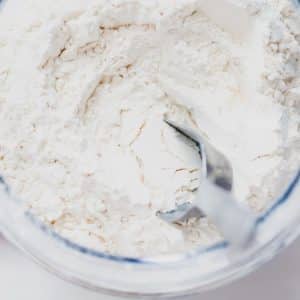
DIY Gluten Free Flour Blend
Ingredients
- 3 cups white rice flour 533.7 grams
- 1 ½ cups sorghum flour 227.4 grams
- 1 ½ cups brown rice flour 232.3 grams
- 1 ½ cups potato starch 277.4 grams * see notes if you are nightshade free
- ¾ cup tapioca starch 102.3 grams
- 3 tablespoons psyllium husk powder 31.7 grams
Email This Recipe To Me!
Instructions
- Add all of the flours, starches, and psyllium husk to a large mixing bowl.
- Use a whisk and mix the ingredients together. Take a large spoon and mix the flour, then whisk again. It is critical the flours are completely and evenly blended.
Notes
- If you are nightshade-free, you can use all tapioca starch.
- If you are going to use xanthan or guar gum, reduce the amount of psyllium husk to 1 tablespoon.
- Store in an airtight container or freezer zip-style bag in the refrigerator.
SPECIAL NOTE
Please know that every gluten free flour blend has a different starch to grain ratio. If you use a blend I didn’t test, my rule of thumb is to add more flour if your dough or batter is wet and add more liquid if the dough or batter is too dry!
Nutrition
Nutrition Disclaimer
Nutritional information is an estimate provided to you as a courtesy. You should calculate the actual nutritional information with the products and brands you are using with your preferred nutritional calculator.
I truly hope you enjoy this recipe. I have been testing and creating gluten-free recipes for over 15 years. Creating gluten-free recipes that do not taste gluten-free is my goal for every recipe. Sometimes I only have to test a new recipe a couple of times, and others it takes multiple times. I do this so you get reliable, delicious results every time!

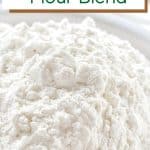
Can I use this blend in your recipes for Bread Machine gluten free bread?
Hi Ronda, I haven’t had a chance to test it in that recipe yet, but it should work. You may need to add a smidgeon more liquid, but keep an eye on the batter consistency and compare it to my photos.
Did you try the blend in your bread machine?
Can your gluten free flour blend be used to make your hamburger rolls. The recipe uses Steve’s gluten free bread flour blend.
Hi Cathy, yes my flour blend works very well in yeast recipes, but you will need to use less liquid ingredients because Steve’s flour blend has a much higher moisture requirement than regular flour blends.
Hello!
I love your site ❤️
What can i replace brown rice flour with?
Thank you!
Hi Veronica, I do have a rice free flour blend recipe, but I haven’t tested it in many recipes…and recently cassava flour was in the news for high lead content. You may try replacing the brown rice with additional sorghum flour, but that is a guesstimate. I am sorry I don’t have a better answer. The cassava flour thing has thrown a wrench in that rice free blend.
Hi there –
If I use this blend to make sourdough bread with my gluten-free sourdough starter, am I correct and understanding that I do not add psyllium powder to this blend. But I will add whole psyllium husk to the bread dough??
Hi Marybeth, if you are making my sourdough with this blend, omit the powdered psyllium and use the psyllium husk in my sourdough recipe. The texture will turn out better.
Thank you!
You are very welcome!
I tried this recipe for the first time today.
I was perfect for the cinnamon rolls. It made them big and puffy! Just like regular gluten rolls. Thanks!
I am so glad you loved using this flour blend recipe. I love how well it works with yeast!
Would your flour mixture taste the same if I omitted the psyllium husks? I mainly use gf flour for biscuits and cookies. We are trying to avoid gums due to digestion issues.
Thank you for all you share! ❤️
Hi Steph, it is fine to omit the psyllium. Be sure to use a different binder when making the recipe. I typically use 3/4 teaspoon of xanthan gum to 2 or 2 1/2 cups flour.
We can’t use the gums. Any other suggestions?
Thanks!
Hi Steph, Many readers can’t use gums. This recipe uses psyllium husk powder, not gums.
Sorry for the confusion.
What can be used in place of the psyllium powder that is not a gum?
Thank you for helping!
Hi Steph, I am really sorry but I am not familiar with binders other than psyllium, xanthan, or guar gum.
Steph,
Konjac root powder works really well as a gum and psyllium husk replacement.
I have a psyllium allergy. How much xanthan gum should I substitute for the psyllium husk?
Hi Margaret, I would say 3/4 teaspoon of xanthan gum per 2 cups of flour used. For this recipe, with 7 1/2 cups of flour total, I would use 3 teaspoons total.
can this be used to make a sourdough starter?
Hi Lexi, It can be used for a starter, but I typically use just brown rice flour for my starter. It is a LOT cheaper to use a single grain flour.
When using this in a recipe can i use a 1:1 ratio? If a recipe calls for 1 cup can i use 1 cup of this blend?
You say i can use for yeast bread. Will it get it fluffy and brown/golden?
Hi Lexi, I would never recommend any blend being used 1:1. Every gluten-free flour blend has a different starch-to-grain ratio. Each has a different weight, and the brand of gluten-free flour you use will affect the moisture of the dough. Many blends used in a recipe calling for wheat flour becomes too dry and dense because of the starch in the blend. My rule of thumb is if your batter or dough is too runny, add more flour, and if it is too thick, add more liquids.
Sandi, I’m wondering what the substitution grams would be in all purpose blend for tapioca starch if nightshade free? Thank you…
Hi Katherine, I am not sure I understand your question. Are you asking what to substitute for the tapioca starch, and if so, the gram weight?
Good evening Sandi,
Im looking at your flour blend wondering if I would be able to use it to make Friendship bread starter. This is the recipe Im looking at: www. cravethegood .com/amish-friendship-bread-starter/
Do you think it could work?
Thank you
Lydia
Hi Lydia, I have never made anything like an Amish friendship bread since going gluten free, so I am not sure the answer to this question.
This is Linda, I don’t have psyllium powder, so was wondering how I can do just the
Whole psyllium husks.??
I can’t have tapioca. What can I use in its place? More potato starch or arrowroot?
Hi Joan, I would use more potato starch. Enjoy!
so Anthony’s psyllium husk won’t turn the dough purple?
Hi Sara, I have never had that brand turn my baked goods purple :-).
Hi Sandi, The dough wasn’t that sticky because I was able to use my cookie scoop. But I think it could’ve used at least another 1/8 cup of flour blend. I had started with 1 cup, then had added another 1/8 cup. I have always wondered if the amount of flour or liquid needed in recipes could be affected with how humid the kitchen is. So now I know how the dough looks and feels; ready for the next time. 🙂
Humidity will definitely affect things. This is why I try not to store flour I use often in the fridge.
Hello Sandi. I noticed your list above, about which recipes you have tried your own flour blend. I am wanting to use your blend in your Vanilla Wafer recipe and also in your Butter Pecan Caramel recipe. Do you know if someone else has tried your blend in these 2 recipes? Or with your experience, do you think it should work fine?
Hi Mary, I don’t have a note of anyone trying my blend in those two recipes yet. If you try, I would consider starting with 2-3 TBSP less flour and add it back if the dough is sticky. I think my DIY blend absorbs a bit more liquid than some blends and I worry your cookies could be dry. Please come back and let me know how it goes.
Hello again Sandi, I did use your blend to make your Vanilla Wafer recipe and I assume I didn’t use enough flour since they didn’t look at all like your pics. It was just hard to gauge since my dough did not look like yours. But I remember another commenter saying something about being hard to manage the dough, yet the cookies still came out great. And that’s what I think also! The dough was chilled and they still spread too much. I still liked the flavor and crispy texture. And since I wanted them to make GF Rum balls for Jan 1, they were perfect! P.S. when I make the Caramel cookies, I will try to remember to post the comment under that category, ok?
Hi Mary, Thank you so much for your note. I haven’t tested my blend in this vanilla wafer recipe yet, so I really appreciate your testing it. It sounds like you did everything right, I think the corn syrup can make the dough a bit tougher. Was your dough sticky?
did you mean to say use arrowroot starch if your are nightshade free?
Hi Sara, I tested this with alternate tapioca starch for the potato starch. I haven’t tested arrowroot yet. In theory, it should be fine, but I haven’t tested it.
Hello… can I replace the psyllium husk powder with whole psyllium husk? How much would I need to use ?
Hi Teri, I have not tested with whole psyllium husk. If you test it, please come back and let me know how it worked.
Hi. I found your cup and gram measurement a bit off. Maybe i am wrong. But i weighed 3 cups white rice fl and was less than 400 grams. Am i missing something ?
Thank you
Chooks
Hi, that is interesting. I wonder if humidity is playing a factor in the measurements? I created this recipe over the summer. How big of a discrepancy did you find? Are you in a humid or dry area? Do you store flour in the refrigerator?
Hi Sandi. Just wondering if I mix all ingredients in my dry container from Vitamix if it is ok to blend the flour ingredients. I always use this container to grind up my chickpeas or rice into flour. Can I make my own rice flour or better to purchase. I can get it ultra fine.
Also if I swapped out psyllium husk for alternative, if recipe works the same. Love your recipes and going to try apple cake into muffins.
Thank you, Sheryl (From Toronto area, Canada)
Hi Sheryl, thank you so much for your question. I have never mixed my flour in a Vitamix, so I am not sure how to advise on that. You can definitely swap the psyllium husk. Just omit it and add one teaspoon of xanthan or guar gum to the recipe you are making. I hope this helps.
Love all the different blends of GF flours. But everything is so high carb. I have been using a mix of almond flour, tapioca and xanthan gum. Has been my go to blend with much reservations. Just would like to use some flour mix that does not have rice in it. Any ideas would be greatly appreciated.
Hi Carol, almond flour and tapioca sounds more paleo in nature. I would look for recipes on paleo sites. I do have this really great paleo biscuit recipe that you will want to try: https://www.fearlessdining.com/paleo-biscuits/ (If you put paleo in my search bar, I have a few other recipes.)
I need to find a good blend for bread and will try this one as your recommendations for steve’s won’t ship to CAD! Anything special to note if I need this for roles, buns & bread?
At the bottom of this post is a list of all recipes I have tested with my blend so far. For bread and rolls, just be sure the dough is workable and not sticky. If you have to add a little more flour or water to get that consistency, it is ok.
Hello. I was wondering if brown ri e flour would work here?
Hi Vicki, do you mean using only brown rice flour without the white rice flour? I haven’t tested that…if you try it, please let me know how it works.
I plan to make your DIY Flour blend tomorrow just because I loved your French Apple Cake! 🙂 Do I understand correctly that all or many of your recipes will work with your DIY? I noted that you also specify what other flours have worked per each recipe. I’m new to your site, so have been scanning recipes.
With this DIY flour recipe, you say to add less psyllium if we intend to add XG. So since I can’t know for sure if a recipe will require XG, then I shouldn’t add the psyllium to the batch of flour blend yet? How would that work?
I am glad you are going to try it. I list recipes in that recipe that I have tested at the bottom. I am trying to test one recipe in each category. I tested pizza, muffins, a cake, etc recipes. I don’t use xanthan gum in the recipe, nor do you need it. Some readers wanted to use both for some reason.
So sorry Sandi, but to clarify, should I add psyllium husk when I make a whole batch of your DIY flour blend?
Or should I wait until I know if a recipe requires me to add XG, since I would need less psyllium, as per your recipe? And if that is the case, when I DO use XG, how much psyllium per cup should I add?
I probably only make GF dessert recipes (cakes, fruit pies or crumbles, cookies) and not breads, so do you think those type recipes on your site would usually require XG as their binder?
Or do you think that I’m better off using a store-bought GF flour since they’re only dessert recipes?
Hi Mary, I add it to my blend, but if you prefer to add it after you know about xg, that is fine too. It is up to you which blend you use. Many are really great.
Hi Sandi. I did make a batch of your DIY Flour blend. I made the Creamy Apple Cake and it worked out perfectly for this recipe. And I only added 1 T Psyllium to the batch, as per your recipe, since I will probably be adding XG if the recipe asks for it.
I am so glad you loved this cake with the flour blend. Thank you so much for testing it :-).
We like corn flour, but when making corn pasta, cornmeal with 1/3 corn starch. Works well with yucca noodles and potato noodles. Have you tried bean flour? Some beans, like pintos and sulfur beans were bred to use as flour. They will grind very fine even in a blender. Mind, to get out the gassy part, knock off the skins, then finish grinding.
These are great tips. Thank you so much, Tsi.
Can you substitute Sorghum with buckwheat please?
I have never baked with buckwheat so I do not have an answer for you. It will depend on liquid absorption of the two different flours.
Hello! Thank you for all your awesome receipes. I have made a few. I got all the stuff to make your DIY flour blend. I am really looking for a bread machine receipe that will taste good and bake well. I see that you listed your Bread machine receipe worked well with this DIY flour blend, but when I click on the link that receipe lists our the various flours not the flour blend. I am unsure of how much of the flour blend to use. Would you clarify that please? Thank you!
Of course. You would add up the total flour in the recipe for the bread, or 3 cups. Use that amount of my gluten free flour blend. With my blend you can omit the flaxseed meal if you like.
Hi Again,
I just posted, but don’t find my post.:( So forgive me if this is repeat! I was just wondering in which recipes you use your DIY flour? I really like this flour recipe as I’m allergic to nightshades, and most commercial GF flours have potato starch as an ingredient. However, I’m not finding this flour mix in your recipes. Can you help me out on this one? I LOVE your blog and have made several of your recipes with very good outcomes. Thank you for all your hard work on behalf of us with allergies!
Hi Sheryl, I list the recipes I have tested my flour blend in at the bottom. You can get there easily via the Table Of Contents. I am working to test it in a recipe for each category first…but it is time-consuming.
Hello,
Can you tell me in what recipes you use this DIY flour blend? I LOVE your blog and your recipes, but I don’t see that you call for this flour blend in a lot of your recipes. So I was wondering why. Thank you.
Hi! Me again. I clicked on the link for the white rice flour and it took me to authentic foods sweet rice flour. Does your blend work better with sweet rice flour or can I use the regular white rice flour from authentic foods?
Hi Esther, I didn’t realize those were links in the recipe card. I changed that link to the proper white rice flour. Don’t use sweet rice flour. Thank you for bringing this to my attention.
I would love to try your flour blend as it uses the same ingredients mine does, but most of the amounts are different. Mine doesn’t have the psyllium husk in it, though, and that’s not something I have on hand. Would it work to leave all of the psyllium husk out and put the correct amount of xanthan gum in my recipes?
Hi, you can easily omit the psyllium, and add one teaspoon xanthan gum to the recipe you are making (don’t add xanthan into the bulk flour.)
Is this psyllium a special kind that does not turn your bread purple?
I am a regular follower and appreciate your recipes. Lately I’ve begun to question the amounts of rice flour in so many GF breads, mixes, crackers, and recipes due to the concerns about high levels of arsenic in both white and brown rice. I think this becomes more of a concern with children and that’s who I’m making GF foods for. Is this something that you’ve thought about or a concern for you? I’m questioning some things about what and how I feed my child.
Hi April. I completely understand your concern about rice with arsenic in gluten free. I wish there was an easy answer. I have been working on a gluten free flour blend for quite some time and it just doesn’t work well without rice flour. I have really tried. You may want to try some of the blogs that use coconut/almond flour blends without grains to avoid rice blends.
Hi! Do you think this flour blend will work for cakes too? Thank you!!
Hi Esther, I just used this flour in my gluten free lemon layer cake recipe. It turned out really good.